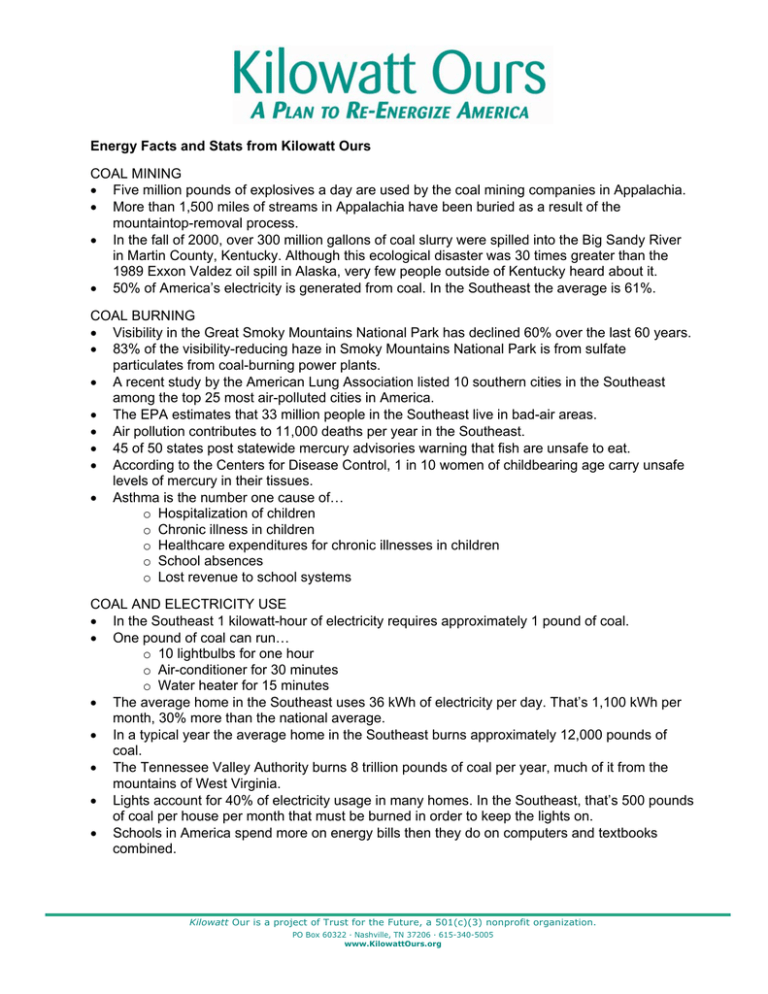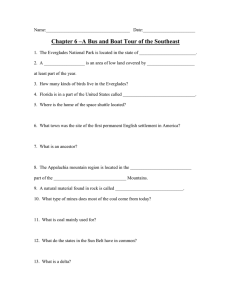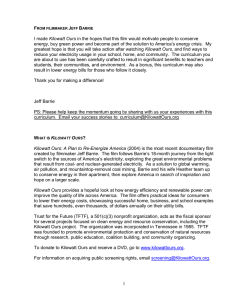Energy Facts and Stats from Kilowatt Ours COAL MINING • Five
advertisement

Energy Facts and Stats from Kilowatt Ours COAL MINING • Five million pounds of explosives a day are used by the coal mining companies in Appalachia. • More than 1,500 miles of streams in Appalachia have been buried as a result of the mountaintop-removal process. • In the fall of 2000, over 300 million gallons of coal slurry were spilled into the Big Sandy River in Martin County, Kentucky. Although this ecological disaster was 30 times greater than the 1989 Exxon Valdez oil spill in Alaska, very few people outside of Kentucky heard about it. • 50% of America’s electricity is generated from coal. In the Southeast the average is 61%. COAL BURNING • Visibility in the Great Smoky Mountains National Park has declined 60% over the last 60 years. • 83% of the visibility-reducing haze in Smoky Mountains National Park is from sulfate particulates from coal-burning power plants. • A recent study by the American Lung Association listed 10 southern cities in the Southeast among the top 25 most air-polluted cities in America. • The EPA estimates that 33 million people in the Southeast live in bad-air areas. • Air pollution contributes to 11,000 deaths per year in the Southeast. • 45 of 50 states post statewide mercury advisories warning that fish are unsafe to eat. • According to the Centers for Disease Control, 1 in 10 women of childbearing age carry unsafe levels of mercury in their tissues. • Asthma is the number one cause of… o Hospitalization of children o Chronic illness in children o Healthcare expenditures for chronic illnesses in children o School absences o Lost revenue to school systems COAL AND ELECTRICITY USE • In the Southeast 1 kilowatt-hour of electricity requires approximately 1 pound of coal. • One pound of coal can run… o 10 lightbulbs for one hour o Air-conditioner for 30 minutes o Water heater for 15 minutes • The average home in the Southeast uses 36 kWh of electricity per day. That’s 1,100 kWh per month, 30% more than the national average. • In a typical year the average home in the Southeast burns approximately 12,000 pounds of coal. • The Tennessee Valley Authority burns 8 trillion pounds of coal per year, much of it from the mountains of West Virginia. • Lights account for 40% of electricity usage in many homes. In the Southeast, that’s 500 pounds of coal per house per month that must be burned in order to keep the lights on. • Schools in America spend more on energy bills then they do on computers and textbooks combined. Kilowatt Our is a project of Trust for the Future, a 501(c)(3) nonprofit organization. PO Box 60322 · Nashville, TN 37206 · 615-340-5005 www.KilowattOurs.org Energy Facts and Stats from Kilowatt Ours (continued) ENERGY EFFICIENCY • Compact fluorescent lightbulbs use 20% as much electricity as a 100-watt incandescent bulb and last years longer too. • New energy-efficient refrigerators are 40% more efficient than they were just two years ago. • If just one room in every home in America were lit by Energy Star lighting, it would be like removing 1 trillion pounds of greenhouse gases from the atmosphere. • A typical washing machine uses 1,000 kWh per year of electricity. An energy-efficient frontloading washer uses only 280 kWh. GREEN POWER • Recycling one aluminum can saves enough energy to power a television for three hours. (America only recycles about half of its aluminum cans.) • Less than one-tenth of one percent of America’s energy comes from green power sources. • Half the power needs of a city could be met if all the flat rooftop space were covered with solar collectors. ENERGY EFFICIENCY CASE STUDIES • The city of Birmingham, Alabama, now saves $220,000 after upgrading all 700 street intersections with LED traffic signals. • When the Sumner County School System in Tennessee found that geothermal heating and cooling in a new school helped them save $5,000 per month on energy, they decided to retrofit every school in the county with this cost-cutting technology. • Smith Middle School in North Carolina uses a technique called “daylighting” to flood classrooms with natural light. • The Sullivan County School System in Tennessee finances their $24 million energy upgrade with the $1 million they save on energy every year. • 31,500,000 kWh could be saved every year if every exit sign in America were upgraded to LED bulb. Kilowatt Our is a project of Trust for the Future, a 501(c)(3) nonprofit organization. PO Box 60322 · Nashville, TN 37206 · 615-340-5005 www.KilowattOurs.org





